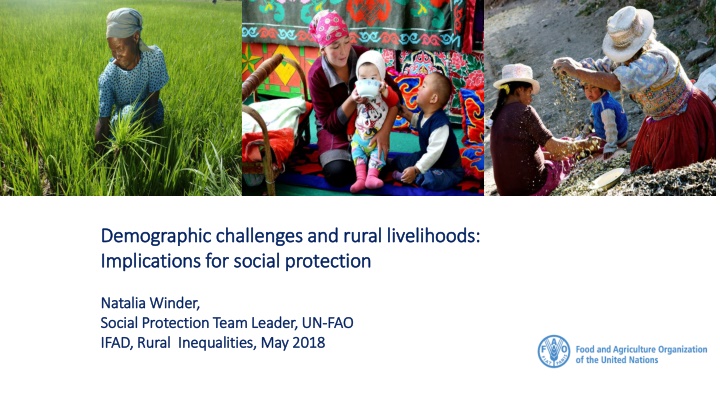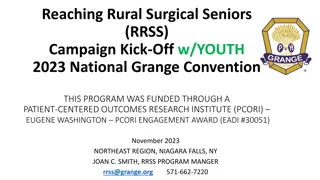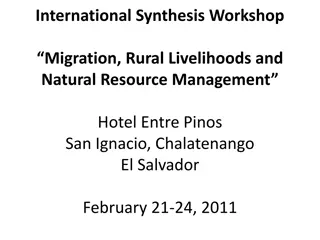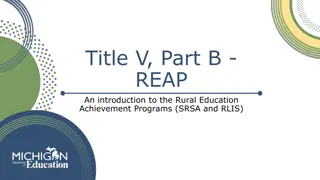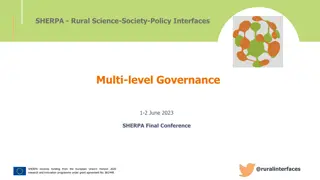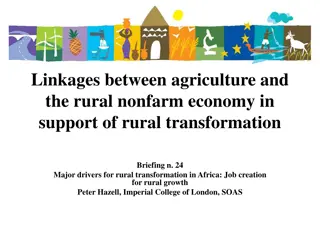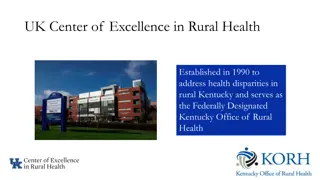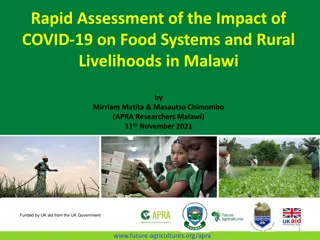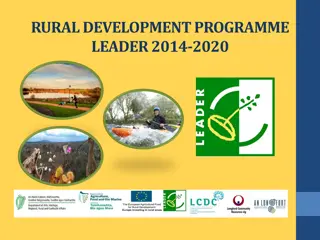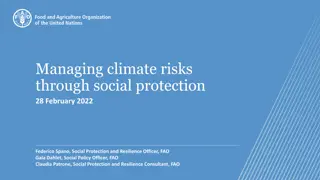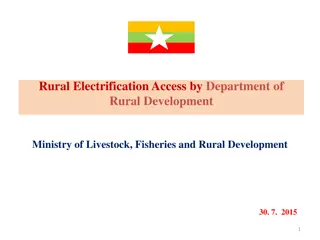Demographic Challenges in Rural Livelihoods: Implications for Social Protection
This publication discusses demographic challenges faced in rural areas, focusing on older persons and youth, and their implications for social protection coverage. It highlights the importance of addressing issues such as rural ageing populations, youth bulges, and the impact on social assistance programs, particularly in Sub-Saharan Africa. The content emphasizes the need to transition social protection from mere protection to sustainable production to address these challenges effectively.
Download Presentation

Please find below an Image/Link to download the presentation.
The content on the website is provided AS IS for your information and personal use only. It may not be sold, licensed, or shared on other websites without obtaining consent from the author.If you encounter any issues during the download, it is possible that the publisher has removed the file from their server.
You are allowed to download the files provided on this website for personal or commercial use, subject to the condition that they are used lawfully. All files are the property of their respective owners.
The content on the website is provided AS IS for your information and personal use only. It may not be sold, licensed, or shared on other websites without obtaining consent from the author.
E N D
Presentation Transcript
Demographic challenges and rural livelihoods: Demographic challenges and rural livelihoods: Implications for social protection Implications for social protection Natalia Winder, Natalia Winder, Social Protection Team Leader, UN Social Protection Team Leader, UN- -FAO IFAD, Rural Inequalities, May 2018 IFAD, Rural Inequalities, May 2018 FAO
Overview Overview The economic and productive impacts of social assistance: the case of Sub-Saharan Africa Demographic challenges in rural areas: older persons and youth Implications for social protection coverage Opportunities Social Protection: From Protection to Production
Social assistance: Social assistance: enhancing the economic capacity of the poor enhancing the economic capacity of the poor Social assistance (national cash transfer programmes) have become key components of poverty reduction strategies across regio Ample evidence on impacts, including productive and economic FAO/UNICEF/UNC/SUK Partnership: Transfer Project Developing solid evidence on the broad range of impacts of national social assistance pprogrammes in 7 countries in SSA Profile of beneficiaries Greater impacts on labor able and children, but: also impacts on labor constrained, including older persons care of children; impacts on adolescent well-being, particularly in long-standing programmes Social Protection: From Protection to Production
Age distribution of program beneficiaries Age distribution of program beneficiaries
Demographic challenges Demographic challenges Recent UNDESA figures showing demographic transition across developing countries: declining levels of lifetime fertility, reduction in infant mortality and increasing life expectancy Rural areas: Rural areas: Rural ageing population Youth bulge - particularly in Africa *Implications in terms of: Social protection coverage* and adequacy* Agriculture sector- depopulation/migration and availability of workforce Increasing vulnerability of those left behind, labor constrained Compounding challenges: limited coverage of social protection in rural areas; added vulnerabilities due to conflict, climate change; low productivity of subsistence farms, limited opportunities for industrialization Social Protection: From Protection to Production
Poverty challenges: Rural areas Poverty challenges: Rural areas 767 million 767 million people still live in extreme poverty Inequalities still pervasive 2 out of 3 2 out of 3 people in extreme poverty live in rural areas Most of the poor depend at least partly- on agriculture fishing or forest resources for their livelihoods Income inequality has risen Income inequality has risen within countries with rural areas being disadvantaged, which leads to spatial poverty traps traps Poor job prospects, limited social protection coverage and Poor job prospects, limited social protection coverage and and and decent work deficits decent work deficits are among the determinants of rural poverty and distress migration Women, Women, youth youth, migrants, , migrants, older persons, older persons, people with disabilities, indigenous people, especially those in rural disabilities, indigenous people, especially those in rural areas, areas, continue to face particular inequalities and discrimination Climate change and conflict Climate change and conflict are exacerbating the current situation agriculture, spatial poverty people with Social Protection: From Protection to Production
Social Protection coverage challenge: Rural areas Social Protection coverage challenge: Rural areas Countries committed to ensure coverage of social protection to all (SDG 1.3) Coverage across all components of social protection: social assistance, social security and labor market policies Progress in terms of expansion of social protection programmes over the last two decades, But But Only 45 remaining 55 per cent 4 billion people are left unprotected. (ILO 2018) 45 per cent of the global population is effectively covered by at least one social benefit, while the Social assistance transfers have the broadest coverage in these regions. Social insurance is limited. In South Asia and Sub-Saharan Africa, the share of poorest quintile receives social assistance in 20- 30% (70% in LAC) In India, 90% of the agricultural sector is informal; in Lebanon, agricultural is seasonal and not formalized within labor legislation Social Protection: From Protection to Production
Access to social assistance*: Access to social assistance*: Rural areas >urban Rural areas >urban Share of rural and urban population covered by social assistance, by region All countries (92) East Asia & the Pacific, other than China (10) Europe & Central Asia(18) Rural Latin America & the Caribbean (20) Urban Notes: Number of countries in parentheses. Source: SOFA 2015/ Authors calculations using World Bank (2015d). Middle East & North Africa (6) South Asia (8) Sub Saharan Africa (30) 0% 10% 20% 30% 40% 50% 60% 70% Social Protection: From Protection to Production
Access to social insurance*: Access to social insurance*: rural areas lagging behind rural areas lagging behind Share of rural and urban population covered by social insurance, by region Coverage of All Social Insurence in rural and urban areas Sub Sahara Africa (29) South Asia (6) Near East and North Africa (6) Latin America and the Caribbean (18) Europe and central Asia (19) East Asia and the Pacific (15) 0% 10% 20% 30% 40% 50% 60% Urban Rural Source: ASPIRE dataset April 2018 The number of countries included is 92. The group of schemes included in the SI definitions are Old Age Contributory Pensions-Old age, Survivors and Disability- and Other Social Insurance- Occupational injury benefits, Paid sick leave, Health Insurance, Maternity and Other social insurance. Social Protection: From Protection to Production
Zooming in: Youth Zooming in: Youth Burgeoning youth populations lacking decent job prospects Burgeoning youth populations lacking decent job prospects Mostly working in the informal sector and in vulnerable jobs Mostly working in the informal sector and in vulnerable jobs, as own- account workers or contributing family workers, mainly in agriculture In SSA, youth working poverty rates are at their highest, estimated to be 69 per cent in 2017 per cent in 2017 (both moderate and extreme poverty) 10 10- -12 million new jobs 12 million new jobs will have to be created in Africa to absorb the new entrants into the labour market 69 Africa per year until 2035 10 Social Protection: From Protection to Production
Social protection coverage: Youth Social protection coverage: Youth In terms of coverage- looking at child grants (only), continues to be limited and many of these do not cover adolescents/youth Only 35 per cent of children worldwide enjoy effective access to social protection, albeit with significant regional disparities. Almost two-thirds of children globally 1.3 billion children are not covered, most of them living in Africa and Asia. (ILO 2018) Very few programs that are specifically targeted to youth, focused on specific needs as they enter labor market- with the exception of some contributory programmes Example: Only 21.8 per cent of unemployed workers are covered by unemployment benefits, 152 million unemployed workers remain without coverage. Unemployment benefits for first-time job seekers- limited (ILO 2018) Evidence (*UNICEF) on the impact of national cash transfers in adolescent well being and risk; access to secondary education, but limited analysis on access to jobs/markets New emerging work in Tanzania (looking at economic impacts) Social Protection: From Protection to Production
Social protection coverage: Youth Social protection coverage: Youth Many outstanding questions: What happens to children (18+) that graduate from social assistance programmes? Links to job intermediation, skill training and specific support? How many and what type of jobs (farm & off-farm) need to be created in rural areas to absorb new labour labour market entrants? market entrants? Tools and Investment: what needs to be done needs to be done to ensure decent jobs in rural areas, quality education and training, and better matching of labour supply and demand? Policy Coherence: What are the most effective policies effective policies to harness the development potential of decent employment in order to create sustainable livelihood options in rural areas? absorb new Social Protection: From Protection to Production
Social protection coverage (Older people) Social protection coverage (Older people) Rural ageing population (Data: ILO 2018 report) Rural ageing population (Data: ILO 2018 report) Worldwide, 68 per cent of people above retirement age receive an old-age pension, which is associated with the expansion of both non-contributory and contributory pensions in many middle- and low-income countries . But.. Policy concerns/perceptions persist: Pensions do not reach poorest in rural areas; too many barriers to access Policy concerns/perceptions persist: Pensions do not reach poorest in rural areas; too many barriers to access Health coverage: in rural areas where 56 per cent of the population lack health coverage as compared to 22 per cent in urban areas. Implications of limited to pensions not only in terms of well being of ageing households but also in terms of access to land for youth Social Protection: From Protection to Production
Barriers to access to social protection When social protection systems exit inadequacy of benefits Inadequacy in terms of size, correspondence based on specific livelihoods Labor-based social insurance not applicable if agriculture is not formalized under labor legislation* Accessibility of services (eg: health) in rural settings Limited resources to contribute to systems Lack of trust in social security systems or perception that benefits are not relevant (ie: no benefits regarding crop loss or disaster impact) Structure of social security systems may not be compatible with the instability (or seasonality) of agricultural employment (ie: timeframe to receive benefits) Youth: limited specific design, linked with access to job market and productive opportunities (linkages with rural finance, training and other) Social Protection: From Protection to Production
Some options to explore. Visibility Visibility- - nature and scope of coverage gap nature and scope of coverage gap Farmer registries, with socio-economic variables (Eg: Lebanon) Alternative protection modalities, which are flexible and Alternative protection modalities, which are flexible and take into account the diversity of the informal sector and their specific characteristics, eg (mutual funds, farmer funds, etc) more flexible contribution payments to take into account income fluctuations or seasonal revenues introducing specific mechanisms to determine contribution levels for employees and self- employed workers where real incomes are difficult to assess (capitation or lump-sum payment based on size of economic activity, on area cultivated, etc.); Innovation Innovation: Eg: Community based health insurance (Ghana, Ethiopia); build on/or strengthen existing rural/community based sp structures Specific to youth and older people?? Social Protection: From Protection to Production
Many thanks Many thanks http://www.fao.org/social http://www.fao.org/social- -protection/en/ protection/en/
